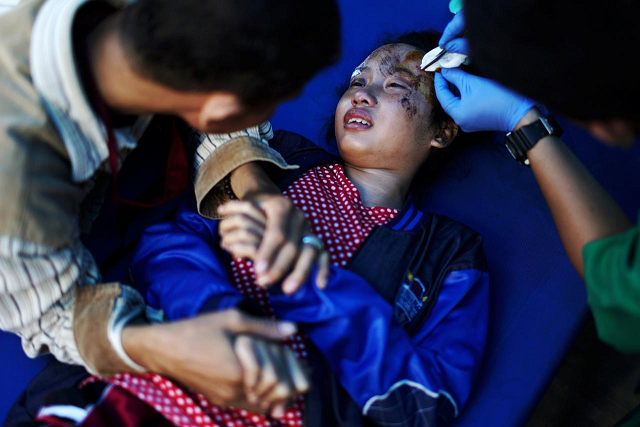
Desperate residents on the west coast of Sulawesi island were scavenging for food in farms and orchards as the government struggled to overcome shortages of water, food, shelter and fuel in a disaster zone with no power and degraded communications.
Chaos has loomed at times with angry people in the region’s main city of Palu, 1,500 km (930 miles) northeast of Jakarta, looting shops and thronging its small airport, scrambling for any flight out.
The official death toll from last Friday’s 7.5 magnitude quake has risen to 1,407, many killed by tsunami waves and landslides it triggered. Officials say the toll will rise.
Indonesia tsunami worsened by shape of Palu bay: scientists
Most of the confirmed dead have come from Palu and losses in remote areas remain unknown. Communications are down and bridges and roads have been destroyed or blocked by slips.
But international efforts to help are gearing up, after the government overcame a traditional reluctance to take foreign aid.
“The government of Indonesia is experienced and well-equipped in managing natural disasters, but sometimes, as with all other countries, outside help is also needed,” UN Under-Secretary-General for Humanitarian Affairs and Emergency Relief Coordinator Mark Lowcock said in a statement.
He announced an allocation of $15 million.
The International Federation of Red Cross and Red Crescent Societies said it was appealing for 22 million Swiss francs ($22 million) to help Indonesia.
The United States had provided initial funding, deployed government disaster experts and was working to determine what other help could be given, the State Department said earlier this week.
Some aid from Britain and Australia as also due to arrive on Thursday.
In all, about 20 countries have offered help, Indonesia has said.
In Palu, some shops and banks reopened on Thursday and a major mobile phone network was back into operation. A sense of calm seemed to be returning with orderly queues at petrol stations after the arrival of fuel shipments.
‘DIFFICULT TIME’
Indonesian Central Bank Governor Perry Warjiyo played down the overall impact on Southeast Asia’s biggest economy of the disaster in Sulawesi, and of earlier deadly quakes on the tourist island of Lombok.
“This is really a challenging and difficult time for Indonesia and for all of us, but we are united and we stand strong and we are confident to withstand this difficult time,” he told a briefing of the Jakarta Foreign Correspondents Club on Wednesday evening.
Bank Indonesia was helping to restore payment systems and some cash machines were working again in Palu as banks reopened, he said.
Indonesia has long been known to be vulnerable to quakes and tsunamis.
In 2004, a quake off Sumatra island triggered a tsunami across the Indian Ocean that killed 226,000 people in 13 countries, including more than 120,000 in Indonesia.
Safety measures implemented after that disaster, including tsunami warning systems, failed on Friday for various reasons, including government neglect, a lack of funding and vandalism.
UN warns Indonesia quake needs 'vast' as toll nears 1,400
A system of tsunami-detecting buoys has been out of action since 2012. Widodo said this week it had to be repaired and properly maintained.
Widodo, on his second visit to the disaster zone on Wednesday, acknowledged the aid effort had yet to reach maximum capacity. In particular, he cited inadequate logistics support and fuel supplies.
Also problematic has been a lack of heavy equipment for rescue workers and food, water and shelter for some 70,000 displaced people.
Rescue workers have begun to reach more remote areas in a disaster zone that includes 1.4 million people, but hundreds of thousands have received no aid.























COMMENTS
Comments are moderated and generally will be posted if they are on-topic and not abusive.
For more information, please see our Comments FAQ